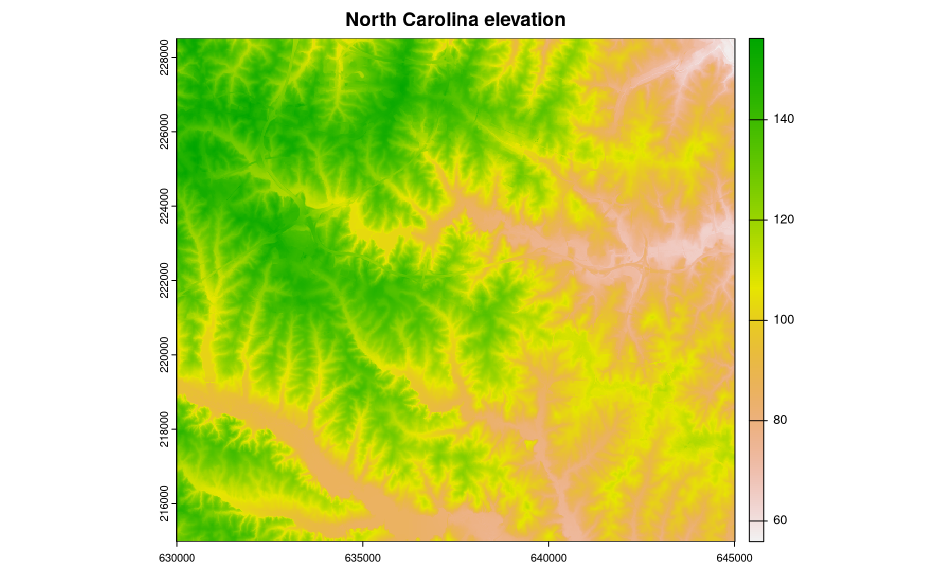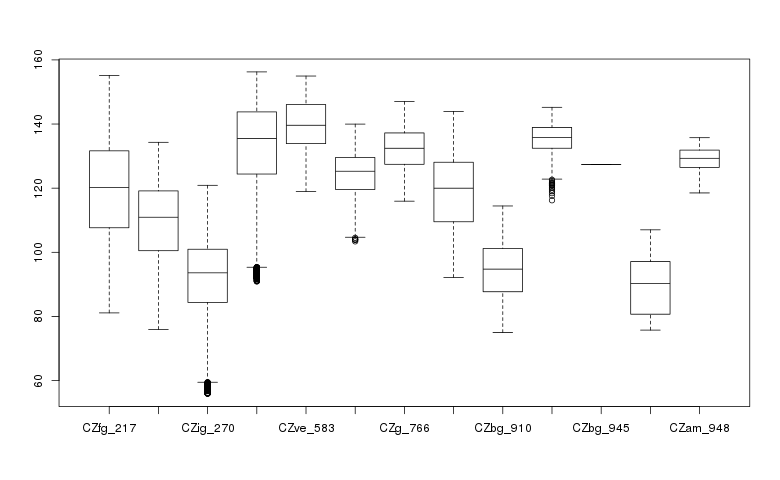R statistics/rgrass
This page refers to the usage of R within a GRASS GIS 7 session. (see also R_statistics/spgrass6)
Startup
- First start a GRASS GIS session. Then, at the GRASS command line start R (for a 'rstudio' session, see below)
- In this example we will use the North Carolina sample dataset.
Reset the region settings to the defaults
GRASS 7.0.1svn (nc_spm_08_grass7):~ > g.region -d
Launch R from the GRASS prompt
GRASS 7.0.1svn (nc_spm_08_grass7):~ > R
Load the rgrass7 library:
> library(rgrass7)
Get the GRASS environment (mapset, region, map projection, etc.); you can display the metadata for your location by printing G:
> G <- gmeta()
gisdbase /home/neteler/grassdata location nc_spm_08_grass7 mapset user1 rows 620 columns 1630 north 320000 south 10000 west 120000 east 935000 nsres 500 ewres 500 projection +proj=lcc +lat_1=36.16666666666666 +lat_2=34.33333333333334 +lat_0=33.75 +lon_0=-79 +x_0=609601.22 +y_0=0 +no_defs +a=6378137 +rf=298.257222101 +towgs84=0.000,0.000,0.000 +to_meter=1
Listing of existing maps
List available vector maps:
> execGRASS("g.list", parameters = list(type = "vector"))
List selected vector maps (wildcard):
> execGRASS("g.list", parameters = list(type = "vector", pattern = "precip*"))
Save selected vector maps into R vector:
> my_vmaps <- execGRASS("g.list", parameters = list(type = "vector", pattern = "precip*"))
> attributes(my_vmaps)
> attributes(my_vmaps)$resOut
List available raster maps:
> execGRASS("g.list", parameters = list(type = "raster"))
List selected raster maps (wildcard):
> execGRASS("g.list", parameters = list(type = "raster", pattern = "lsat7_2002*"))
Reading in data
Read in two raster maps (North Carolina sample dataset):
> ncdata <- readRAST(c("geology_30m", "elevation"), cat=c(TRUE, FALSE), ignore.stderr=TRUE, plugin=NULL)
The metadata are accessed and available, but are not (yet) used to structure the sp class objects, in this case a SpatialGridDataFrame object filled with data from two North Carolina layers. Here is a plot of the elevation data:
> image(ncdata, attr = 2, col = terrain.colors(20))
Add a title to the plot:
> title("North Carolina elevation")

In addition, we can show what is going on inside the objects read into R:
> str(G)
List of 26 $ DEBUG : chr "0" $ LOCATION_NAME: chr "nc_spm_08_grass7" $ GISDBASE : chr "/home/veroandreo/grassdata" $ MAPSET : chr "PERMANENT" $ GUI : chr "wxpython" $ projection : chr "99" $ zone : chr "0" $ n : num 228500 $ s : num 215000 $ w : num 630000 $ e : num 645000 $ t : num 1 $ b : num 0 $ nsres : num 27.5 $ nsres3 : num 10 $ ewres : num 37.5 $ ewres3 : num 10 $ tbres : num 1 $ rows : int 491 $ rows3 : int 1350 $ cols : int 400 $ cols3 : int 1500 $ depths : int 1 $ cells : chr "196400" $ cells3 : chr "2025000" $ proj4 : chr "+proj=lcc +lat_1=36.16666666666666 +lat_2=34.33333333333334 +lat_0=33.75 +lon_0=-79 +x_0=609601.22 +y_0=0 +no_defs +a=6378137 +"| __truncated__ - attr(*, "class")= chr "gmeta"
> summary(ncdata)
Object of class SpatialGridDataFrame
Coordinates:
min max
[1,] 630000 645000
[2,] 215000 228500
Is projected: TRUE
proj4string :
[+proj=lcc +lat_1=36.16666666666666 +lat_2=34.33333333333334
+lat_0=33.75 +lon_0=-79 +x_0=609601.22 +y_0=0 +no_defs +a=6378137
+rf=298.257222101 +towgs84=0.000,0.000,0.000 +to_meter=1]
Grid attributes:
cellcentre.offset cellsize cells.dim
1 630018.8 37.50000 400
2 215013.7 27.49491 491
Data attributes:
geology_30m elevation
CZfg_217:70381 Min. : 55.92
CZig_270:66861 1st Qu.: 94.78
CZbg_405:24561 Median :108.88
CZlg_262:19287 Mean :110.38
CZam_862: 6017 3rd Qu.:126.78
CZbg_910: 4351 Max. :156.25
(Other) : 4942
Summarizing data
We can create a table of cell counts:
> table(ncdata$geology_30m)
| CZfg_217 | CZlg_262 | CZig_270 | CZbg_405 | CZve_583 | CZam_720 | CZg_766 | CZam_862 | CZbg_910 | Km_921 | CZbg_945 | CZam_946 | CZam_948 |
|---|---|---|---|---|---|---|---|---|---|---|---|---|
| 70381 | 19287 | 66861 | 24561 | 2089 | 467 | 691 | 6017 | 4351 | 1211 | 1 | 398 | 85 |
And compare with the equivalent GRASS module:
> execGRASS("r.stats", flags=c("c", "l"), parameters=list(input="geology_30m"), ignore.stderr=TRUE)
217 CZfg 70381 262 CZlg 19287 270 CZig 66861 405 CZbg 24561 583 CZve 2089 720 CZam 467 766 CZg 691 862 CZam 6017 910 CZbg 4351 921 Km 1211 945 CZbg 1 946 CZam 398 948 CZam 85
Create a box plot of geologic types at different elevations:
> boxplot(ncdata$elevation ~ ncdata$geology_30m, medlwd = 1)

Exporting data back to GRASS
Finally, a SpatialGridDataFrame object is written back to a GRASS raster map:
First prepare some data: (square root of elevation)
> ncdata$sqdem <- sqrt(ncdata$elevation)
Export data from R back into a GRASS raster map:
> writeRAST(ncdata, "sqdemNC", zcol="sqdem", ignore.stderr=TRUE)
Check that it imported into GRASS ok:
> execGRASS("r.info", parameters=list(map="sqdemNC"))
+----------------------------------------------------------------------------+ | Map: sqdemNC Date: Sun Jul 19 13:06:34 2015 | | Mapset: PERMANENT Login of Creator: veroandreo | | Location: nc_spm_08_grass7 | | DataBase: /home/veroandreo/grassdata | | Title: ( sqdemNC ) | | Timestamp: none | |----------------------------------------------------------------------------| | | | Type of Map: raster Number of Categories: 0 | | Data Type: DCELL | | Rows: 491 | | Columns: 400 | | Total Cells: 196400 | | Projection: Lambert Conformal Conic | | N: 228500 S: 215000.0002 Res: 27.49490794 | | E: 645000 W: 630000 Res: 37.5 | | Range of data: min = 7.47818253045085 max = 12.5000787351036 | | | | Data Description: | | generated by r.in.bin | | | | Comments: | | r.in.bin -d input="/home/veroandreo/grassdata/nc_spm_08_grass7/PERMA\ | | NENT/.tmp/localhost.localdomain/X666" output="sqdemNC" bytes=8 heade\ | | r=0 bands=1 order="native" north=228500 south=215000.0002 east=64500\ | | 0 west=630000 rows=491 cols=400 anull=6 | | | +----------------------------------------------------------------------------+